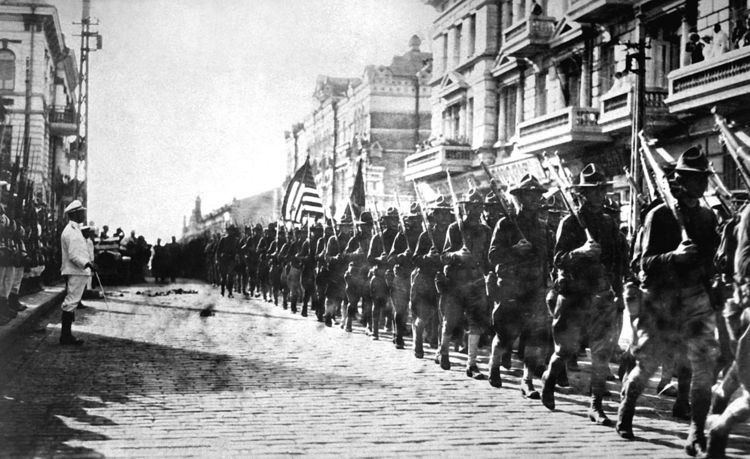 | ||
The American Expeditionary Force Siberia (AEF Siberia) was a United States Army force that was involved in the Russian Civil War in Vladivostok, Russian Empire, during the end of World War I after the October Revolution, from 1918 to 1920. As a result of this expedition, which failed but became known to the Bolsheviks, early relations between the United States and the Soviet Union would be low.
Contents
U.S. President Woodrow Wilson's claimed objectives for sending troops to Siberia were as much diplomatic as they were military. One major reason was to rescue the 40,000 men of the Czechoslovak Legion, who were being held up by Bolshevik forces as they attempted to make their way along the Trans-Siberian Railroad to Vladivostok, and it was hoped, eventually to the Western Front. Another major reason was to protect the large quantities of military supplies and railroad rolling stock that the United States had sent to the Russian Far East in support of the prior Russian government's war efforts on the Eastern Front. Equally stressed by Wilson was the need to "steady any efforts at self-government or self defense in which the Russians themselves may be willing to accept assistance." At the time, Bolshevik forces controlled only small pockets in Siberia and President Wilson wanted to make sure that neither Cossack marauders nor the Japanese military would take advantage of the unstable political environment along the strategic railroad line and in the resource-rich Siberian regions that straddled it.[1]
Concurrently and for similar reasons, about 5,000 American soldiers were sent to Arkhangelsk (Archangel), Russia by Wilson as part of the separate Polar Bear Expedition.
American Expeditionary Force Siberia
The American Expeditionary Force Siberia was commanded by Major General William S. Graves and eventually totaled 7,950 officers and enlisted men. The AEF Siberia included the U.S. Army's 27th and 31st Infantry Regiments, plus large numbers of volunteers from the 12th Infantry Regiments, 13th, and 62nd Infantry Regiments of the 8th Division, Graves' former division command.[2]
The U.S. troops were equipped with M1918 Browning Automatic Rifles (BAR) and Auto-5 shotguns/trench clearers, M1903 Springfield rifles and M1911 .45 caliber pistols, depending on their duties. Mosin–Nagant rifles were also used.
Although General Graves did not arrive in Siberia until September 4, 1918, the first 3,000 American troops disembarked in Vladivostok between August 15 and August 21, 1918. They were quickly assigned guard duty along segments of the railway between Vladivostok and Nikolsk-Ussuriski in the north.[3]
Unlike his Allied counterparts, General Graves believed their mission in Siberia was to provide protection for American-supplied property and to help the Czechoslovak Legion evacuate Russia, and that it did not include fighting against the Bolsheviks. Repeatedly calling for restraint, Graves often clashed with commanders of British, French and Japanese forces, who also had troops in the region and who wanted him to take a more active part in the military intervention in Siberia.
To operate the Trans-Siberian Railroad the Russian Railway Service Corps was formed of US personnel.
Logistic problems and casualties
The experience in Siberia for the soldiers was miserable. Problems with fuel, ammunition, supplies and food were widespread. Horses accustomed to temperate climates were unable to function in sub-zero Russia. Water-cooled machine guns froze and became useless.
The last American soldiers left Siberia on April 1, 1920. During their 19 months in Siberia, 189 soldiers of the American Expeditionary Force Siberia died from all causes. As a comparison, the smaller American North Russia Expeditionary Force experienced 235 deaths from all causes during their 9 months of fighting near Arkhangelsk.[4]
